Massoud M. Engineering Thermofluids: Thermodynamics, Fluid Mechanics, and Heat Transfer
Подождите немного. Документ загружается.

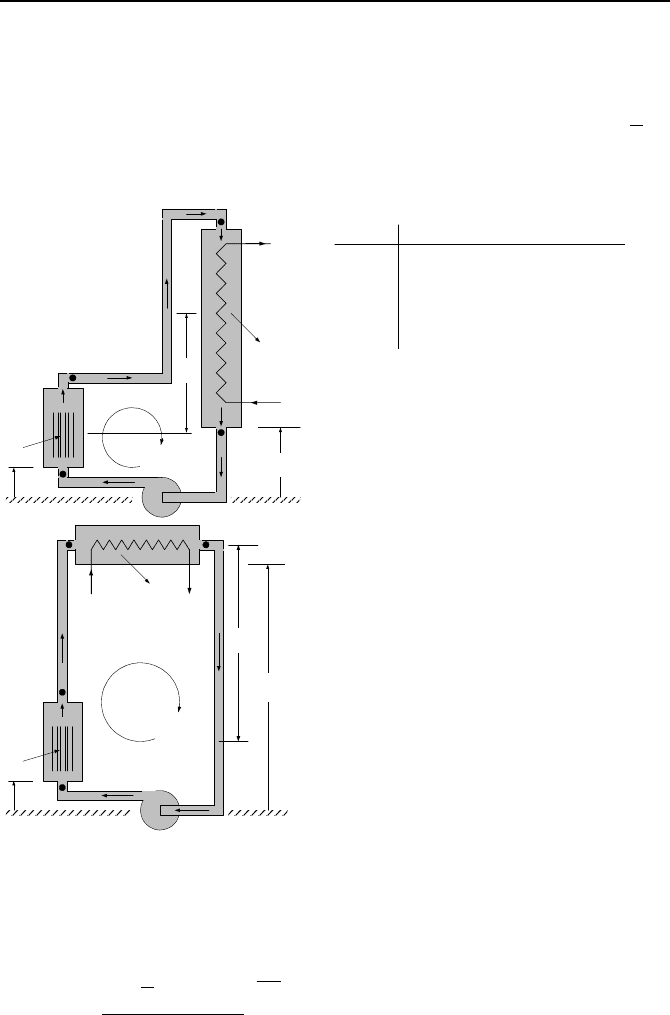
832 VId. Applications: Simulation of Thermofluid Systems
b) Prepare a table of loop flow rate and loop temperature gradient for various val-
ues of H
th
. To do this, start from H
th
= 0.3 m and conclude at Hth = 15 m using a 1
m height increment. c) Plot the values for
m
and for T
H
versus H
th
. d) Compare
the vertical and the horizontal orientation of the heat sink and comment on the ad-
vantages and drawbacks of each orientation. Other Data: P = 4.48 MPa,
T
=
243 C,
Q
= 15 MW
1
2
3
4
Water
Steam
Q
Q
H
th
Z
V
Z
SG
Region
A (m
2
)
L (m) D
e
(m)
K
1-2
2-3
3-4
4-1
1.59
1.86
1.31
2.44
13.26
17.83
10.67
16.00
0.71
0.013
0.91
0.014
6
10
4
2
1
2
3
Water Steam
Q
Q
Z
V
4
H
th
Z
SG
16. An approximate value for the mass flow rate in a natural circulation loop as
given by Equation VId.3.18 was derived assuming a constant friction factor. a)
By using Equations IIIb.3.2 and IIIb.3.6 show that in general, the mass flow rate is
given by:
n
p
th
NC
Rc
Qg
m
−
¸
¸
¹
·
¨
¨
©
§
=
3
1
Core
2
H2
ρβ
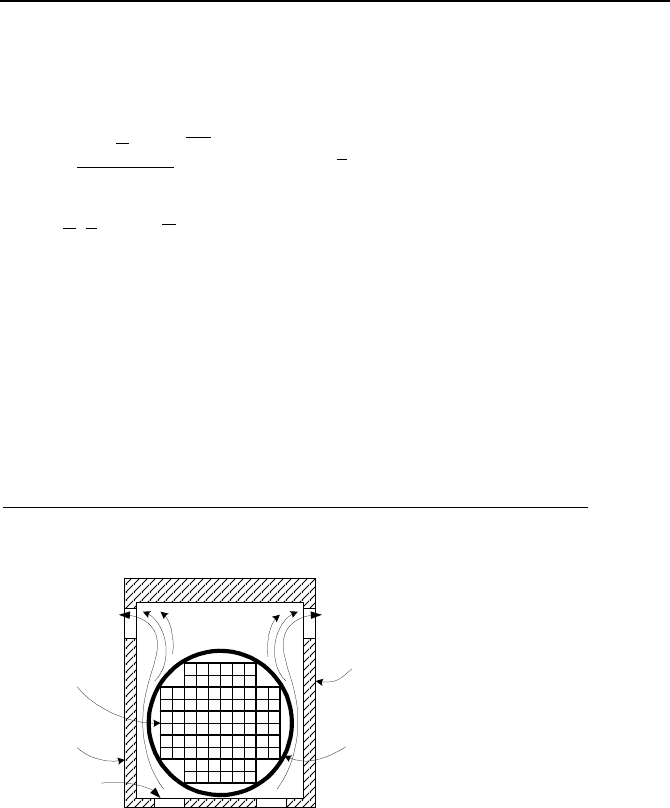
Questions and Problems 833
where n = 0.2 for turbulent flow in all the sections of the flow loop and n = 1 for
laminar flow in all the sections of the flow loop. b) Show that the maximum
power that can be removed from the heat source in a natural circulation loop is
given by:
()
p
nn
n
th
cT
R
g
Q
)2/()3(
2
1
2
H2
−−
−
∆
»
»
¼
º
«
«
¬
ª
=
ρβ
where ,,
p
c
ρ
and
T
are the loop average density, specific heat, and temperature.
Also H
th
is the system thermal length, as defined in Problem 15.
17. Some nuclear power plants, which are facing space limitation in their spent
fuel pool, place older fuel assemblies in steel cylinders, referred to as dry shielded
canisters (DSC). The DSC is then hermetically sealed and placed horizontally in-
side a concrete bunker, known as the horizontal storage module (HSM). Decay
heat is removed by natural convection. Colder air entering the HSM through the
inlet screen leaves through the vents located at the top of HSM. The loss coeffi-
cient and flow area of the inlet and exit ports are as follows:
K
Outer screen
K
Inner screen
K
Enterance/Exit
Area (m
2
)
Inlet port 0.4 0.5 1.4 0.5
Exit port 0.4 0.5 1.0 1.0
Concrete
Fuel
Assembly
DSC
Exit Vent
HSM
Inlet Port
Total loss coefficient and flow area associated with the flow through the HSM are
2.5 and 0.5 m
2
, respectively. Total rate of decay heat for the DSC is 15 kW. The
system thermal length, as defined in Problem 14 is 3.5 m. Air enters the HSM at a
temperature of 22 C. Assume air at exit is well mixed. Use the given data to find
a) temperature rise, b) flow rate of air through the HSM, and c) total pressure drop
from inlet to exit.
18. A tank containing saturated liquid undergoes a rapid drop in pressure. This
results in flashing to take place in the tank. In the absence of any other process,
use the conservation equations of mass and energy to derive a relation for the
flashing mass flow rate in terms of the depressurization rate.

834 VId. Applications: Simulation of Thermofluid Systems
[Ans.: )/](v)/)[(/( dtdPdPdhhmm
vffglfl
−−=
].
19. A tank containing saturated steam undergoes a rapid drop in pressure. This
results in rainout from the steam. In the absence of any other process, use the con-
servation equations of mass and energy to derive a relation for the rainout mass
flow rate in terms of the depressurization rate.
[Ans.:
)/](v)/)[(/( dtdPdPdhhmm
vgfgvfl
−=
].
20. Consider a tank filled with steam at enthalpy h
v
. A spray valve is opened al-
lowing water at a rate of
sr
m
and at enthalpy of h
sp
to flow into the vapor space.
The rate of steam condensation on the spray droplets is
sc
m
. Assuming both
spray water and the condensate reach saturation, write a steady state energy bal-
ance and find the rate of spray condensation.
[Ans.:
)/()(/
fvspfspsc
hhhhmm −−=
].
21. Find the spray flow rate into the pressurizer of a PWR by using a force bal-
ance around a closed loop. This loop starts from the inlet to the spray line and in-
cludes spray line, spray valve, pressurizer, surge line, hot leg, steam generator
primary side, reactor coolant pump suction pipe, reactor coolant pump, and reactor
coolant pump discharge line. The spray valve flow area and loss coefficient are
A
sp
and K
sp
, respectively. For given height and elevations, find the spray flow rate
and the condition at which there is no spray flow.
{Ans.:
0.5 0.5
,
[( ) ( / )( ) ( / ) ] ( / K )
sp HL SG CL l P c P P CL c sp sp sp
mPPP ggLZ ggZA
ρρ
=∆ +∆ +∆ + + −
}.
Spray
Valve
L
P
Z
P
Z
sp
CL
HL
RCP
Core
SG
RPV
PZR
22. Schematics of a PWR reactor coolant system and the secondary side of the
steam generator are shown in the figure. The reactor is shutdown and the decay
power is being steadily removed by the residual heat removal system (not shown
in the figure). At this steady state operation, the average temperature in the pri-
mary side is equal to the temperature of water in the secondary side of the steam
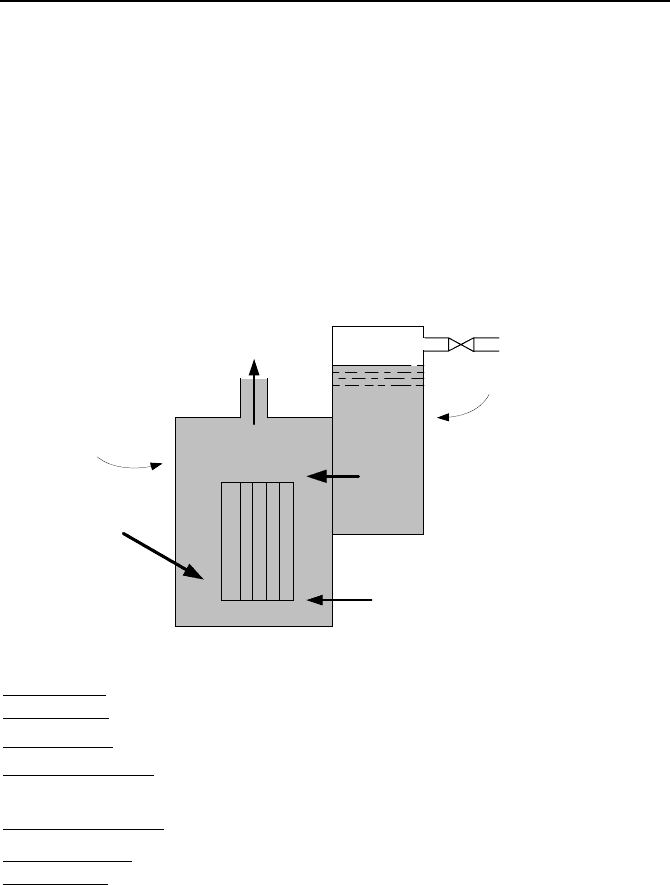
Questions and Problems 835
generator, hence, there is no heat transfer taking place in the steam generator
tubes. At time zero, we lose the cooling of the residual heat removal system, we
inject water at a specified flow rate and enthalpy into the primary side, and we
turn on the reactor coolant pumps (not shown in the figure). a) Set up the govern-
ing differential equations. Use one control volume for the primary side water and
one for the secondary side water, b) solve the differential equations to find the
primary side and secondary side temperatures as functions of time and other sys-
tem parameters specified below, c) use the given data and plot the surge flow rate
(out of the primary side) as a function of time for the first ten minutes from the
start of the event. The primary and the secondary sides are identified with sub-
scripts P and S, respectively.
Decay
Q
ii
hm ,
SG
Q
su
m
PWR Primary side
PWR Secondary side
Volume data: V
P
= 260 m
3
(9,181 ft
3
), V
S
= 85 m
3
(3000 ft
3
),
Pressure data
: P
P
= 2 MPa (290 psia), P
S
= 138 kPa (20 psia),
Injection data
:
i
V
= 8.33 lit/s (132 GPM), T
i
= 43 C (110 F),
Heat transfer data
: A
SG-tubes
= 8,383 m
2
(90,232 ft
2
), U = 4531 W/m
2
·C (798
Btu/h·ft
2
·F)
Power addition data
:
decay
Q
= 3 MW,
pump
Q
= 17 MW
Initial condition
: T
P
= T
S
= 105 C (221 F).
Assumptions
:
a) The primary and secondary sides pressures remain constant throughout the
event,
b) water in both control volumes remains subcooled for the duration of interest
such that du
≅ dh ≅ cdT,
c) the overall heat transfer coefficient U remains constant,
d) no water enters or leaves the secondary side.
23. The steam line in a BWR is equipped with a relief valve to discharge steam to
the pressure suppression pool during an emergency. The valve opens upon the
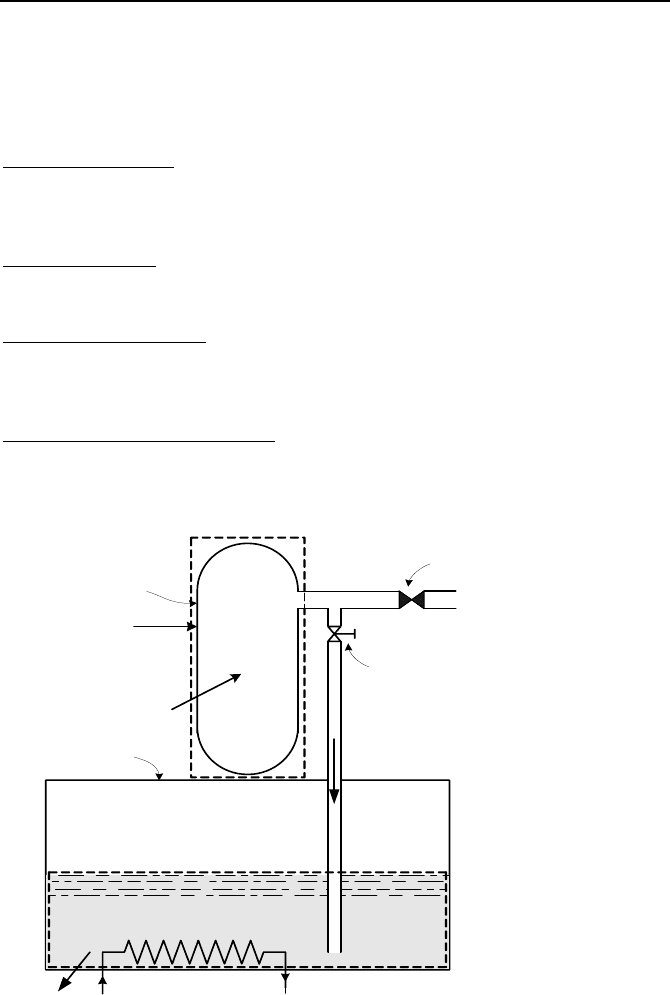
836 VId. Applications: Simulation of Thermofluid Systems
closure of the isolation valve. To prevent overcooling of the reactor pressure ves-
sel, the discharge of steam through the valve must not result in a cooldown rate in
excess of 100 F/h. Use the data and the associated simplifying assumptions to
find pressure in the reactor pressure vessel (RPV) and temperature in the suppres-
sion pool as functions of time for a discharge period of 10 minutes.
RPV initial condition
:
Pressure: 1015 psia (7 MPa),
water volume: 14,583 ft
3
(413 m
3
),
steam volume: 8370 ft
3
(237 m
3
),
RPV injection data
:
feedwater flow rate: 1,252,000 lbm/h (32 kg/s), feedwater enthalpy: 335 Btu/lbm
(780 kJ/kg),
RPV power addition data
:
rate of heat deposition to the mixture from the RPV internal structure: 950 Btu/s
(§ 1 MW), rate of heat deposition to the mixture from radioisotope decay: 1% of
the reactor nominal power of 3434 MWth,
Suppression pool initial condition
:
Water mass: 7.6E6 lbm (3,447 kg), water temperature: 90 F (32 C), pressure: 14.7
psia (1 atm).
Residual heat removal
Reactor pressure vessel
FW
m
Decay
Q
g
m
Isolation valve
Relief valve
Suppression pool
R
Q

Questions and Problems 837
RPV assumptions:
a) water and steam are completely mixed and remain in thermodynamic equilib-
rium throughout the discharge period,
b) only saturated steam leaves the RPV,
c) the rate of heat deposition to the RPV from both sources remain constant
throughout the discharge period.
Suppression pool assumptions
:
a) water in the suppression pool remains subcooled at atmospheric pressure
throughout the event, and
b) no residual heat removal system is activated for the suppression pool as long as
the pool temperature remains below 110 F (43 C).
[Ans.: P
RPV
§ 900 psia and T
Pool
§ 110 F].
24. Find the cooldown rate and the suppression pool temperature in Problem 23
for a case that the relief valve has stuck open for five minutes. The valve flow
area is 0.1 ft
2
(≈ 0.01 m
2
).
25. Our goal in this problem is to find the rate of depressurization in a PWR plant.
In this case, the depressurization is due to the pressurizer spray valve failure in the
open position. The stuck open spray valve allows colder water from the cold leg
to be sprayed into the bulk vapor space. Find the time it takes for pressurizer
pressure of 15.5 MPa to drop to 13 MPa. Also calculate the water volume. As-
sume no other processes take place in the pressurizer. Further assume that the
spray flow rate and enthalpy remain constant and
surgeoutsp
mm
−
=
.
Data:
28=
sp
m
kg/s, h
sp
= 1250 kJ/kg, (V
l
)
initial
= 18 m
3
and (V
v
)
initial
= 28 m
3
.
26. A hermetically sealed tank contains a mixture of water and steam at pressure
P
1
. The tank wall is made of carbon steel. The wall on the inside is covered by a
stainless steel cladding and on the outside by a layer of insulation. Use the speci-
fied data to find the time it takes for the tank pressure to drop to P
2
MPa.
Pressure data
: Initial pressure: 2030.5 psia, final pressure: 1500.0 psia,
Geometry data
: tank total volume: 1500 ft
3
, water volume fraction: 40%, tank
height: 6 ft, cladding thickness: 0.5 in, carbon steel thickness: 5 in, insulation
thickness: 3 in,
Heat transfer data
: ambient temperature: 85 F, heat transfer coefficient from the
mixture to the inside of the tank wall: 150 Btu/h·ft
2
·F, heat transfer coefficient
from the tank to the ambient: 25 Btu/h·ft
2
·F,
Property data
: stainless steeel: k = 8.6 Btu/h·ft·F, c
p
= 0.123 Btu/lbm·F,
ρ
= 488
lbm/ft
3
,
carbon steel: k
carbon steel
= 29.6 Btu/h·ft·F, c
p
= 0.11 Btu/lbm·F,
ρ
= 487 lbm/ft
3
,
insulation: k = 0.3 Btu/h·ft·F, c
p
= 0.037 Btu/lbm·F, and
ρ
= 27 lbm/ft
3
Assumptions:
a) heat loss takes place from all surfaces and
b) heat transfer coefficients remain constant throughout the event.
[Ans.: about 20 hours].
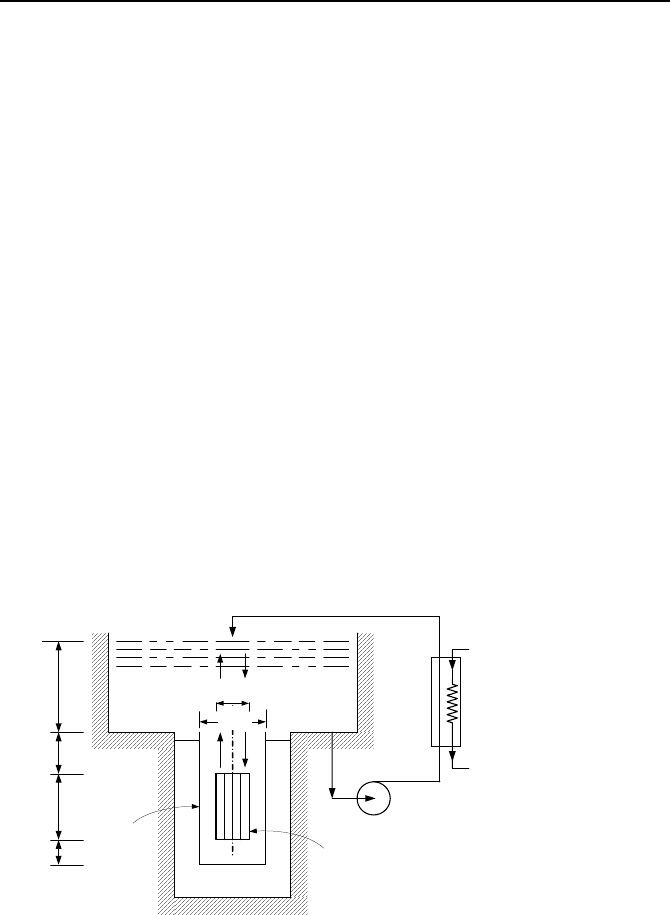
838 VId. Applications: Simulation of Thermofluid Systems
27. A tank contains saturated steam at 10.4 MPa. The height and the inside di-
ameter of the thank are 9 m and 2.5 m, respectively. The bottom of the tank is
connected to a supply piping with the admission valve fully closed. We open the
admission valve and let water at a rate of 8 lit/s, a pressure of 17 MPa, and a tem-
perature of 275 C enter the tank. We close the admission valve after 20 minutes.
a) Use an isentropic compression assumption for the steam region to find the pres-
sure in the steam dome immediately after the valve is closed.
b) Revise your estimate by considering the effect of heat transfer to the wall and
on the water surface.
c) Find the tank pressure 15 minutes after the admission valve is closed. The tank
has a wall thickness of 14 cm and is not insulated. The ambient temperature is
45 C and the heat transfer coefficient to ambient is 15 W/m·C.
28. Shown in the figure is a PWR reactor vessel, with the vessel head removed.
Initially there are no fuel assemblies in the core and the vessel and pool are full of
water. We now place the assemblies in the core. The heat produced in the core,
due to the decay of the radio-nuclides must be removed. For this purpose, water
from the bottom of the pool is circulated through a heat exchanger and the colder
water is returned to the top of the pool. In this way, the core is cooled solely by
natural circulation. Use the specified data to estimate the flow rate through the
core.
Data: h
LP
= 3 m, h
C
= 3.5 m, h
UP
= 3.8 m, h
Pool
= 7 m, D
C
= 2.5 m, D
V
= 11.3 m,
A
Pool
= 162.5 m
2
, T
initial
= 50 C, Core decay power = 10 MW, Flow rate through the
pump = 200 lit/s.
Pool
Core
Vessel
h
LP
h
C
h
UP
h
Pool
D
V
D
C
Heat Exchanger
29. A right circular cylinder tank, having a volume of 44 m
3
, contains a saturated
mixture of water and steam at 15 MPa. The tank has a height of 10 m and a wall
thickness of 14 cm. The ambient is quiescent air at 35 C and 1 atm. The initial
steam quality is 99%. The tank is fully insulated with negligible heat loss. We
now, remove the insulation and let heat loss to ambient take place from the top
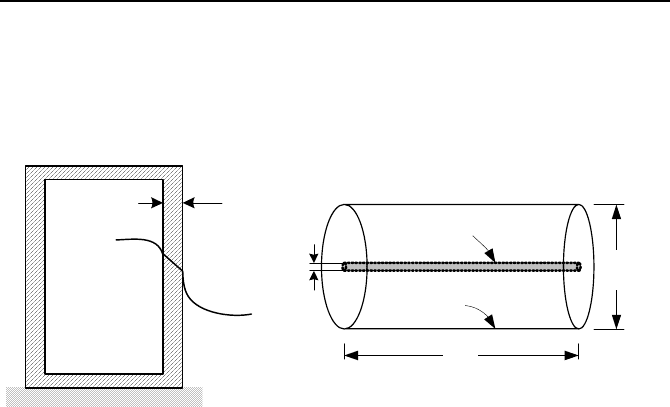
Questions and Problems 839
and the cylindrical surface. Estimate the value of the following variables after one
hour a) steam pressure, b) steam temperature, c) wall temperature facing the
steam, d) wall temperature facing the ambient air, e) water level in the tank.
[Ans. P
2
= 14.17 MPa, T
2
= 337.5 C, T
wi
= 337.5 C, T
wo
= 333.6 C, L
water
=
13 cm].
δ
T
a
T
s
Fuel rod
Canister
D
d
L
Problem 29 Problem 30
30. A canister of diameter D, length L, and wall thickness
δ
has an initial tem-
perature of T
c
, We now evacuate the air from the canister by using a vacuum
pump and place a spent fuel rod while maintaining the wall temperature at T
c
. The
spent fuel rod produces heat at rate of 5 W. The canister is exposed to air at 35 C
and a heat transfer coefficient of 5 W/m
2
·C. Plot the spent fuel and the canister
wall temperatures versus time for a duration of 18 hours. To simplify the analysis
a) assume that the fuel rod is bare UO
2
, b) ignore conduction heat transfer between
the rod and the canister ends, c) use a lumped capacitance for the fuel as well as
the canister wall . Heat transfer takes place at all surfaces. Use, d = 2 mm, D = 10
cm, L = 3 m,
ε
UO2
= 0.8. Canister is made of stainless steel with a wall thickness
of 2 cm (
ε
= 0.4).
31. The models developed in Chapter VId to analyze the primary and the secon-
dary sides of a PWR are based on the thermodynamic equilibrium assumption, ex-
cept for the pressurizer and the secondary side of the steam generator, which were
analyzed based on the thermodynamic non-equilibrium model. In the lumped pa-
rameter approach, the perfect mixing assumption is used and only one temperature
is allocated to a node. Thus, a multi-node representation was required for regions
such as the core and the steam generator primary side in which large temperature
gradients exist (Figures VId.2.1, VId.3.2, and VId.7.1).
Another approach, originally developed by Myers and employed by Kao, allo-
cates only one node to a region even if there is a large temperature gradient in the
region. For example, one node is used to represent the PWR core despite the large
temperature rise over the core. Similarly, the tube bundle region of the steam gen-
erator with large density gradient is modeled by only one control volume. This is
possible by the introduction of the linear enthalpy profile model. In this model a
volume-averaged mixture density,
ρ
*
is defined as:

840 VId. Applications: Simulation of Thermofluid Systems
³
V
*
V),(
V
1
dhP
mm
ρρ
=
Similarly, a volume-averaged mixture enthalpy h
*
is defined as:
³
V
*
V),(
V
1
dhhPh
mmm
ρ
=
where subscript m stands for mixture. If the volume-averaged mixture density and
enthalpy are known, then the mass and energy of a node can be found from m =
ρ
*
V and u = h
*
V – PV, respectively. To find the volume-averaged mixture den-
sity and enthalpy in closed form, the mixture density profile in terms of pressure
and enthalpy is needed to develop the above integrals.
a) To find such profile, show that at a given pressure, density of saubcooled water
decreases almost linearly with increasing enthalpy. Also show that the specific
volume of a two-phase mixture and of superheated steam increases linearly with
enthalpy.
b) Now consider control volume i, connected to the control volumes i – 1 and
I + 1. Show that by a linear transformation, the volume-averaged density and en-
thalpy become functions of pressure and the inlet and exit mixture enthalpies,
given by:
³
1,,
,,,
*
,
1,
),(
−
−
=
−
imim
h
h
imimim
i
hh
dhhP
im
im
ρ
ρ
and
³
1,,
,,,,
*
,
1,
),(
−
−
=
−
imim
h
h
imimimim
i
hh
dhhhP
h
im
im
ρ
c) Using the linear enthalpy profile assumption show that in the single-phase re-
gion:
()
1,
,
,
1,
−−
−
∂
∂
+=
iim
im
im
iim
hh
h
ρ
ρρ
where in this region,
ρ
m,i
/ h
m,i
is a constant. Also show that in the two-phase re-
gion:
()
1,
,
,
1,
v
vv
−−
−
∂
∂
+=
iim
im
im
iim
hh
h
where in this region, v
m,i
/ h
m,i
is a constant.
d) Substitute these profiles in the above integrals to obtain expressions for
*
i
ρ
and
*
i
h .

1. Definition of Some Nuclear Engineering Terms 841
VIe. Nuclear Heat Generation
In Chapter IVa, we treated the volumetric heat generation rate, q
′′′
as a known
quantity. The internal heat generation in a substance may be due to various proc-
esses such as electrical resistance, chemical, or nuclear reactions. If the internal
heat generation is due to an electrical resistance, then the calculation of
q
′′′
is
rather trivial. Examples of chemical heat generation include the exothermic reac-
tion of some alloys with water at high temperatures. Zircaloy, for example, reacts
with water at elevated temperatures to produce heat and hydrogen gas. In the case
of the nuclear reaction, however, calculation of the volumetric heat generation rate
is more involved since it requires the study of neutron transport as a result of neu-
tron-nucleus interactions. This is further complicated by the interdependency of
neutron populations on the state of the medium, such as the composition, pressure,
and temperature. In this chapter we first introduce several key terms that play ma-
jor roles in nuclear engineering. This is followed by the derivation of the neutron
transport equation, which is difficult to solve. Therefore, we introduce the appli-
cation of Fick’s law as our constitutive equation to turn the neutron transport
equation into an equation known as the neutron diffusion equation. This is be-
cause the neutron diffusion equation provides nearly accurate results for many ap-
plications and has the additional advantage of being amenable to even analytical
solutions for some familiar geometries. We then proceed to find the rate of nu-
clear heat generation from fission. Finally, we investigate the effect of the neutron
flux on temperature distribution in conventional reactor cores.
1. Definition of Some Nuclear Engineering Terms
1.1. Definitions Pertinent to the Atom and the Nucleus
Atom is defined as the smallest unit of an element that can combine with other
elements. Democritus in the fifth century B.C. believed that an atom is the sim-
plest thing from which all other things are made. The Greek word atomos means
indivisible. It was not until the early 20
th
century that subatomic particles were
identified and the structure of the atom was described in terms of the nucleus and
electrons. The nucleus consists of positively charged protons and neutral neu-
trons. The protons and neutrons are tightly clustered in the nucleus. The nega-
tively charged electrons encircle the nucleus on far away orbits. Indeed the dis-
tance between the closest electron orbit to the nucleus is about 100,000 times the
radius of the nucleus. Even further away is the neighboring nucleus, which is as
far away as about 200,000 times the radius of the nucleus. The diameter of an
atom is generally expressed in terms of angstrom (A
o
), which is 1E–10 m. For ex-
ample, the diameter of a chlorine atom is 2 A
o
. The hydrogen atom has the sim-
plest structure. Its nucleus consists of a proton with one electron in its orbit,
which makes the atom neutral. Helium has two protons and two neutrons in the
nucleus with two electrons orbiting the nucleus. There are a maximum number of
